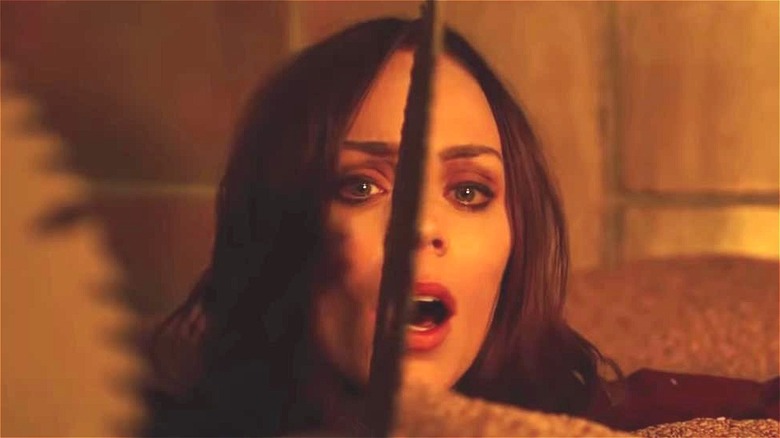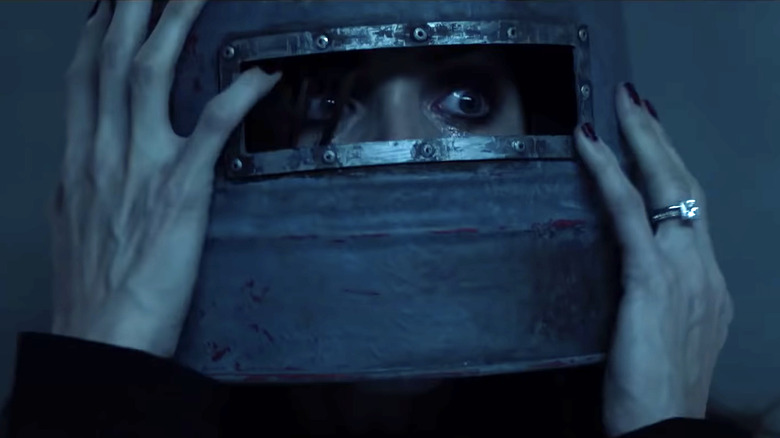Why You Should Watch Jigsaw More Than Once
The 2010 movie "Saw: The Final Chapter" was intended to be the end of the "Saw" saga. But no compelling movie monster stays gone forever. In 2017, "Jigsaw" was released and intended as a soft reboot for the series, notably abandoning the "Saw" title formula and giving the title over to the killer himself. While the film has quite a few elements to satisfy attentive viewers, there's a little more to this horror movie than meets the eye.
Like previous "Saw" franchise installments, "Jigsaw" (via IMDb) sees another group of questionably innocent civilians drawn into a series of sadistic torture traps by an unknown killer whose goal is making a grand statement about human nature. With viewers believing the original Jigsaw, aka John Kramer (Tobin Bell), is supposedly dead and buried for good, the challenge for the 2017 movie was figuring out how to bring him back without breaking credibility with the audience. As such, "Jigsaw" has a tricky narrative structure — even compared to other "Saw" movies — that may require additional viewings from fans to figure out how to story fits in with the rest of the franchise.
The secret of when Jigsaw takes place
One of the cleverest tricks "Jigsaw" viewers can enjoy is its chronological position within the grander "Saw" narrative. Fans of the series may recall that before it was released, it wasn't clear exactly how the killer known as Jigsaw could be back after John Kramer's death in 2006's "Saw III" (via YouTube). Unlike other slasher villains, the Jigsaw character is just a regular guy who can't come back from the dead. One of the things that makes repeat viewings of "Jigsaw" so entertaining is all the little editing tricks used to conceal the twist that the primary barn "game" that serves as the centerpiece of the story is actually taking place 10 years earlier than the rest of film — even before the events of the first "Saw" movie from 2004 (via IMDb).
Viewers discover that not only is the barn event they assumed was happing in the present really Jigsaw's first-ever game that occurs a decade earlier, but that the game's first supposed victim survives and goes on to become Jigsaw's apprentice. The survivor's identity is revealed to be police medical examiner Logan Nelson (Matt Passmore), who is ensnared in the serial killer's web after making a mistake as a hospital employee led to Kramer's terminal cancer prognosis. Jigsaw sees potential in the young staffer and chooses him to carry on his games after his death. This decision allows a version of Jigsaw to continue his reign of terror even after Kramer himself passes away. Thanks to a large dose of cinematic style and flair provided by directors Michael and Peter Spierig, this reveal is a blast to watch, whether you're seeing the movie for the first time or as a repeat screening.
Jigsaw also takes an old-school approach to building suspense
The mystery of when "Jigsaw" takes place is one of the largest and more obvious of its many unusual touches as an installment in the "Saw" franchise. Where previous chapters focused on sadistic gore to elicit a lot of thrills and visceral impact, "Jigsaw" purposely opts for a more old-school approach to building suspense that at times seems to owe more to classic pulp fiction than to any slasher series.
In "Jigsaw," the titular killer's games resemble the kind of death traps that Indiana Jones or Jonny Quest might have had to find their way through. As a result, this storytelling decision gives the film a surprising amount of old-fashioned charm for a "Saw" movie. The way "Jigsaw" manages to thread the needle between the horror requirements of the "Saw" franchise and older, more classical influences is another touch that might have disappointed some hardcore "Saw" fans but makes the movie a real treat for open-minded viewers, and it naturally comes out in stronger relief the more often you watch it.


